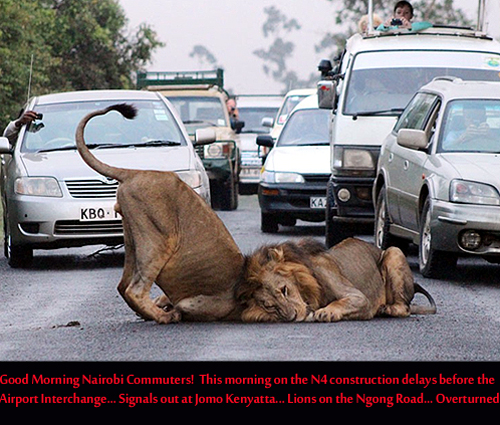 The picture of lions disrupting traffic on the Ngong side of Nairobi is all over the internet, and it’s one of the best examples to date of the terrible predicament big game has in modern Africa.
The picture of lions disrupting traffic on the Ngong side of Nairobi is all over the internet, and it’s one of the best examples to date of the terrible predicament big game has in modern Africa.
I must have received the photo above a dozen times from my loyal readers, so thank you! You can easily find a whole gallery of these blokes by simply choosing “images” on your Google search bar, and typing in “Lions Nairobi Road.”
The Nairobi National Park has always been a misplaced natural wonder. The very first thing you see even today when driving out of the Nairobi airport is the national park, pitifully divided from your highway access by a fence that would have a hard time keeping my lab at bay.
It’s always laid beside the city, even in the old days. It’s always touched the airport. Today one of its seven gates is 4½ miles from the center of the giant megalopolis of Nairobi. This is about as far as the main Broadway Theaters are from Central Park.
In the old days, of course, Nairobi was a cow town with lots of grass and trees and not too many people or buildings. The first thing Kathleen and I did after we first arrived Nairobi in the early 1970s was to rent a car and drive into the park.
We paid our fees, drove about 45 or 46 seconds, and stopped in front of a rhino that was not pleased to have been found.
Until four or five years ago the park suffered some serious setbacks, and many of us were pretty sure it wouldn’t last. The city was exploding and today is one of the most congested megalopolis on earth.
City planning lagged building construction, and today’s highways and skyscrapers are turning Nairobi into an architectural nightmare. It reflects the unstoppable growth of Kenya, and this daunting “progress” concerned a lot of local citizens who love Nairobi National Park.
Motivated by a government decision to lay another highway, but this time right through the middle of the park, the concerned citizens formed a foundation.
The Friends of Nairobi National Park has become one of the most proactive local conservation groups. I think we should take pause from time to time and realize that the celebrity foundations that make it onto our TV, like Daphne Sheldrick’s elephant orphanage and the like, are sometimes disconnected from local needs and aspirations.
FONNAP is just the reverse. Its membership, funding and power are all local, and it’s simply because Nairobi citizens want to save the park, the same way New Yorkers want to save Central Park.
Of course there’s a few bigger things in Nairobi than Central Park, and that’s the problem. Like when lions disrupt the morning commute.
That may have been comic relief to some of the mid level executives who missed their breakfast brief that morning because of it, but it is a harbinger of things to come. And in good ways it represents in real, local time the dilemma we understand better from abroad:
People or Animals?
FONNAP is taking a lot of its direction from American conservation organizations. In association with government agencies like the Kenya Wildlife Service as well as supporting NGOs, land on the outskirts of the park on the opposite side of the city is slowly being bought up or leased by the foundation to keep that southeast side unfenced.
This has allowed a good and renewed migration of many animals that continue across wilderness to places like Amboseli National Park.
Local farmers and land owners receive about $4 per hectare per year to keep their land adjacent the park unfenced. For many ranchers this is a no brainer, for they’ve been successfully raising stock among wild animals for generations.
The successful program spearheaded by the African Wildlife Foundation has been a real success story. And together with a great range of other private endeavors, nearly 16,000 hectares of private land has been attached to the park essentially more than doubling its protected size.
So for the time being, anyway, Nairobi National Park survives, and frankly, I’m rather impressed at what the future may hold.